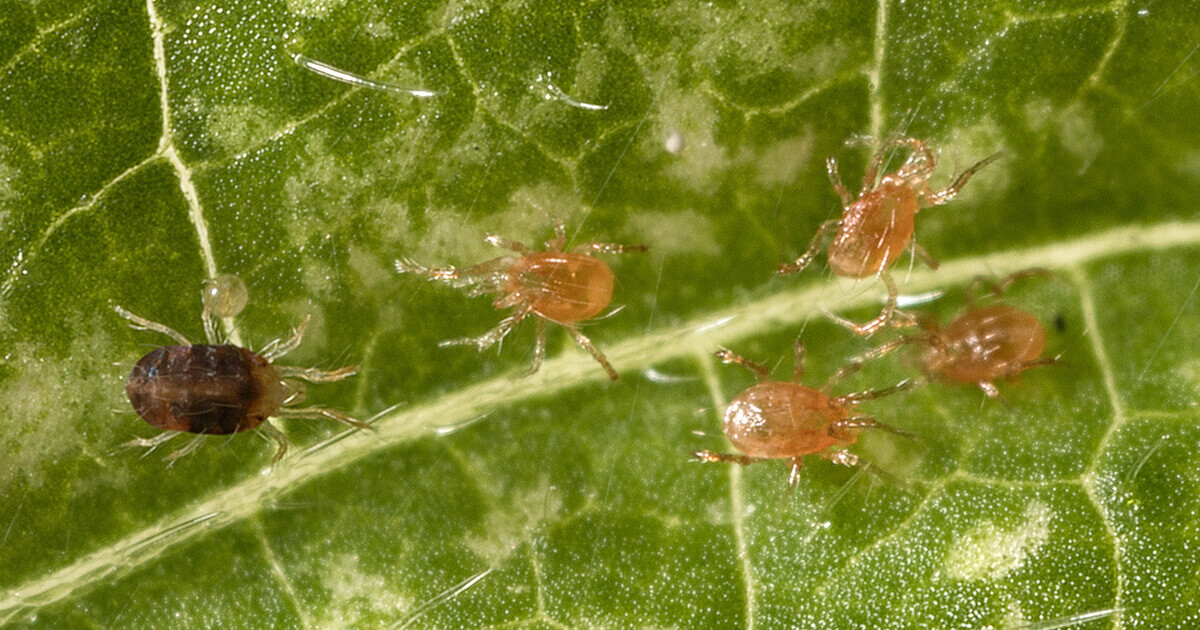How Do I Know if I Have Spider Mites?
The damage of spider mites is very characteristic and appears as small yellow or white spots on the leaves, resulting from the pest feeding on the plant. Webs produced by adults and nymphs are also a red flag.
The most common spider mite species in agricultural and horticultural facilities is the Two Spotted spider mite, Tetranychus urticae. Populations of this pest can best be categorized in three levels: Low, Medium, and High, or 1, 2, and 3, respectively.
Level 1 spider mite population indicates one or two adult or nymph mites on a leaf with minimal damage observed.
Level 2 indicates larger populations on a leaf, consisting of all life stages (egg, larvae, nymph, adult), and more obvious damage symptoms are present.
Finally, level 3 indicates a full breeding ground complete with webbing, significant crop damage, and all stages of the pest's life cycle present.
How Do You Get Rid of Spider Mites?
Introduce predatory mites that are natural enemies of spider mites, such as Phytoseiulus persimilis and Neoseiulus californicus, or gall midge Feltiella acarisuga, depending on the level of infestation and crop type.
Phytoseiulus persimilis is a great spider mite predator as it feeds exclusively on this pest. This voracious predatory mite can easily traverse the webbing. When introduced preventatively or in great enough numbers, Phytoseiulus persimilis will eventually eat every spider mite on a plant, crashing both the pest's population as well as its own. Phytoseiulus persimilis feeds on all stages of spider mites with a preference for eggs.
Predatory mite Neoseiulus californicus is also a great option to use preventively or at the first sign of spider mite damage. Adult predatory mites, nymphs, and larvae vigorously search and prey on them. This predator is helpful to treat hotspots.
Spical (A. californicus) combined with predatory mite Spidex (Phytoseiulus persimilis) can control spider mites colonies and hotspots.
Constant scouting is also essential to be aware of the pest and beneficials population numbers in the crop.
What Causes Spider Mites?
Spider mites are a cosmopolitan pest of plants that occur in every temperate region in the world. There are several reasons why spider mites appear in the crop:
• They can easily be brought into a facility on propagated plant material or employees' clothing.
• They can enter through the air on small strands of webbing they use as a sail to distribute on wind currents.
• Spider mites look for hot, dry conditions in a crop, which cause plant stress.
How Do You Control Two-Spotted Spider Mites?
There are many approaches for effective two-spotted spider mite control, but the method of choice will largely depend on the variables that are unique to the crop needs.
In general, for a curative approach to controlling an established population of spider mites during the vegetative or early-flower period, you might want to introduce predatory mite Phytoseiulus persimilis (Spidex).
If you have dealt with two-spotted spider mites in the past and do not want to deal with them again, natural enemy Amblyseius californicus in our Spical Ulti-Mite sachets is the best option.
Again, the approach to choose will depend on the growing situation, so if you'd like further assistance choosing the right product for you, please contact our customer service team!
What Does a Two-Spotted Spider Mite Look Like?
An adult Two-Spotted Spider Mite is about 1/50 of an inch long, making it nearly impossible to see any detail with the naked eye. Under magnification, however, you will see a beige body with what looks like dark 'spots' on either side of its dorsal section. Nymphs and eggs both look slightly different, but as with most cannabis pests, magnification is crucial to be 100% sure of what you are dealing with.
What Are The Signs of Spider Mites?
After feeding on the plant tissue, Two-Spotted Spider Mite leaves behind what people often describe as 'speckling' or 'stippling' on the top of the leaf surface. The speckling is prolific and looks like a collection of very tiny white spots over the entire leaf surface.
In addition, once populations reach concentrated levels, the spider mites will begin to fortify their territory by spinning fine webbing, allowing them to traverse the canopy with greater ease. If you see this type of webbing, it is for sure there are spider mites in the area, as no other common cannabis pest spins a web.
What Is The Lifespan of Spider Mites?
Given optimal conditions (approximately ~80 °F & low RH), Two-Spotted Spider Mites can hatch from their egg in 3-5 days. Once they reach adulthood, which can occur in as little as five days, each female can lay up to 20 eggs per day and can live for 2 to 4 weeks, laying hundreds of eggs during that time.
An Integrated Pest Management strategy can help keep the spider mite under control while implementing effective practices to prevent the pest from appearing again. We are happy to help you on your journey to a pest and pesticide-free cultivation!



